3 Minutes
Microsoft is reportedly building conversion toolkits to run CUDA-based AI models on AMD GPUs, aiming to cut inference costs and reduce reliance on NVIDIA's CUDA ecosystem. The move could reshape cloud GPU choices for large-scale inference workloads.
Why Microsoft is eyeing AMD for inference
Cloud providers and hyperscalers increasingly separate training from inference. Training still favors the fastest, most optimized hardware, but inference—running models in production—revives cost and efficiency as top priorities. Microsoft sees a huge volume of inference requests across Azure, and AMD's AI accelerators offer a more affordable alternative to expensive NVIDIA cards.
That affordability only matters if existing CUDA-trained models can run on AMD hardware without extensive rewrites. Microsoft’s reported toolkits aim to bridge that gap by translating CUDA model code into ROCm-compatible calls so models can execute on AMD GPUs.
How these toolkits work — a pragmatic translation layer
Breaking CUDA lock-in is not trivial. The CUDA ecosystem is widely adopted, and many production pipelines expect NVIDIA-optimized libraries. One pragmatic solution is a runtime compatibility layer that intercepts CUDA API calls and maps them to ROCm equivalents at runtime. Tools like ZLUDA previously explored this approach by translating calls without requiring full-source recompiles.
Microsoft’s internal toolkits are reportedly following a similar path: converting or redirecting CUDA calls to run on ROCm stacks. That can allow organizations to shift inference workloads to AMD instances on Azure with minimal changes to model artifacts.

Not a silver bullet — compatibility and performance caveats
ROCm is still maturing compared with CUDA, and not every CUDA API or optimized kernel has a one-to-one ROCm counterpart. In some cases, translations can degrade performance or even break complex workloads, which is a risky tradeoff for production data centers that demand predictable latency and throughput.
Microsoft appears to be rolling these toolkits out cautiously, using them in controlled scenarios and collaborating with AMD on hardware optimizations. That suggests the company is trying to balance potential cost savings with the operational stability enterprises expect.
What this means for cloud customers and the GPU market
- Lower inference costs: If toolkits work at scale, organizations could run more inference on AMD-based instances and reduce per-request costs.
- More vendor choice: A reliable CUDA-to-ROCm path would weaken CUDA’s lock-in, giving cloud customers leverage and flexibility.
- Gradual adoption: Expect phased migrations—simple models and batch inference first, then more critical real-time systems as toolchains mature.
Imagine moving most of your inference fleet to cheaper hardware without rewriting models—that’s the appeal. But the reality will depend on how widely ROCm can match CUDA’s performance profile and how quickly Microsoft and AMD close the remaining compatibility gaps.
For now, Microsoft’s effort highlights an industry shift: inference volumes are growing fast, and cost-efficient hardware matters more than ever. If these toolkits scale, they could be a decisive step toward a more heterogeneous GPU landscape in the cloud.
Source: wccftech


Leave a Comment